Related Research Articles

Judaism is an Abrahamic monotheistic ethnic religion that comprises the collective spiritual, cultural, and legal traditions of the Jewish people. Judaism evolved from Yahwism, an ancient Semitic religion of the late Bronze Age to early Iron Age, likely around the 6th/5th century BCE. Along with Samaritanism, to which it is closely related, Judaism is one of the two oldest Abrahamic religions.

Jewish holidays, also known as Jewish festivals or Yamim Tovim, are holidays observed by Jews throughout the Hebrew calendar. They include religious, cultural and national elements, derived from three sources: mitzvot, rabbinic mandates, the history of Judaism, and the State of Israel.

A siddur is a Jewish prayer book containing a set order of daily prayers. The word siddur comes from the Hebrew root ס־ד־ר, meaning 'order.'

Yom Kippur is the holiest day of the year in Judaism. It occurs annually on the 10th of Tishrei, corresponding to a date in late September or early October.
Shemini Atzeret is a Jewish holiday. It is celebrated on the 22nd day of the Hebrew month of Tishrei in the Land of Israel, and on the 22nd and 23rd outside the Land, usually coinciding with late September or early October. It directly follows the Jewish festival of Sukkot which is celebrated for seven days, and thus Shemini Atzeret is literally the eighth day. It is a separate—yet connected—holy day devoted to the spiritual aspects of the festival of Sukkot. Part of its duality as a holy day is that it is simultaneously considered to be both connected to Sukkot and also a separate festival in its own right.

Messianic Judaism is a syncretic Abrahamic new religious movement that combines various Jewish traditions with belief in Jesus of Nazareth as the Messiah. It is widely considered to be a sect of Evangelical Christianity, including by all major groups within mainstream Judaism, but the movement considers itself Jewish. Belief in Jesus as a messianic figure and as divine is considered by Jews to be one of the most defining distinctions between Judaism and Christianity.

Shema Yisrael is a Jewish prayer that serves as a centerpiece of the morning and evening Jewish prayer services. Its first verse encapsulates the monotheistic essence of Judaism: "Hear, O Israel: YHVH is our God, YHVH is one", found in Deuteronomy 6:4.
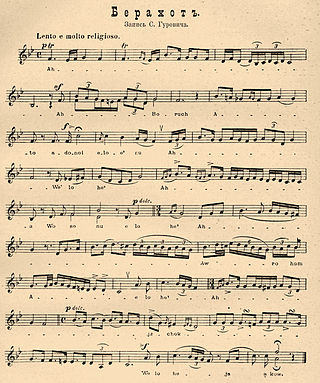
The Amidah, also called the Shemoneh Esreh, is the central prayer of the Jewish liturgy. Observant Jews recite the Amidah at each of three daily prayer services in a typical weekday: morning (Shacharit), afternoon (Mincha), and evening (Ma'ariv). On Shabbat, Rosh Chodesh, and Jewish festivals, a fourth Amidah (Mussaf) is recited after the morning Torah reading, and once per year, a fifth Amidah (Ne'ilah) is recited, around sunset, on Yom Kippur. Due to the importance of the Amidah, in rabbinic literature, it is simply called "hatefila". According to legend, the prayer was composed by the rabbis of the Anshei Knesset HaGedolah. Accordingly, in Judaism, to recite the Amidah is a mitzvah de-rabbanan, i. e., a commandment of rabbinic origin.

Tishrei or Tishri is the first month of the civil year and the seventh month of the ecclesiastical year in the Hebrew calendar. The name of the month is Babylonian. It is a month of 30 days. Tishrei usually occurs in September–October on the Gregorian calendar.
Avodah or Avoda, literally means "work, worship, and service" in Hebrew.
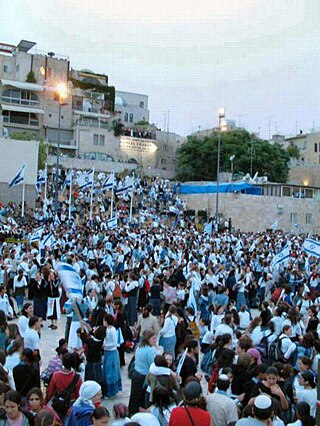
Religious Zionism is a religious denomination that views Zionism as a fundamental component of Orthodox Judaism. Its adherents are also referred to as Dati Leumi, and in Israel, they are most commonly known by the plural form of the first part of that term: Datiim. The community is sometimes called 'Knitted kippah', the typical head covering worn by male adherents to Religious Zionism.
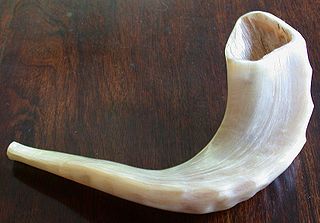
In Judaism, the High Holy Days, also known as High Holidays or Days of Awe consist of:
- strictly, the holidays of Rosh Hashanah and Yom Kippur ;
- by extension, the period of ten days including those holidays, known also as the Ten Days of Repentance ; or,
- by a further extension, the entire 40-day penitential period in the Jewish year from Rosh Chodesh Elul to Yom Kippur, traditionally taken to represent the forty days Moses spent on Mount Sinai before coming down with the second ("replacement") set of the Tablets of Stone.

Bnei Akiva is the largest religious Zionist youth movement in the world, with over 125,000 members in 42 countries. It was first established in Mandatory Palestine in 1929, advocating the values of Torah and labor.
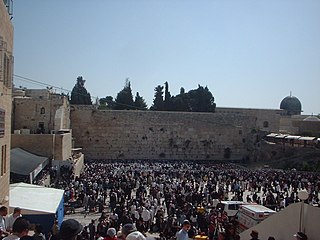
The Priestly Blessing or priestly benediction, also known in rabbinic literature as raising of the hands, rising to the platform, dukhenen, or duchening, is a Hebrew prayer recited by Kohanim. The text of the blessing is found in Numbers 6:23–27.

The Hebrew Roots Movement (HRM) is a syncretic religious movement that advocates adherence to the Torah and believe that Jesus, whom they often refer to by the Hebrew name Yeshua, is the Messiah. The movement emphasizes and promotes the belief that the Law of Moses was not abolished by Jesus and is, therefore, still in effect for his followers. Because HRM believes the Mosaic law is still active, it advocates the keeping of the seventh-day Sabbath; biblical feasts; laws of Kashrut; and circumcision. Some HRM followers also choose to wear tzitzit and other Jewish religious items. However, HRM followers do not generally follow Judaism or embrace the Talmud. Unlike other Christians, most HRM followers reject the traditional holidays of Christmas and Easter, insisting that they are pagan traditions.
Pikuach nefesh, which means "saving a soul" or "saving a life," is the principle in Halakha that the preservation of human life overrides virtually any other religious rule of Judaism. In the event that a person is in critical danger, most mitzvot, become inapplicable if they would hinder the ability to save oneself or someone else. However, there are certain exceptions; some rules and commandments may not be broken under any circumstances and thus may require an act of self-sacrifice.
Shituf is a term used in Jewish sources for the worship of God in a manner which Judaism does not deem to be purely monotheistic. The term connotes a theology that is not outright polytheistic, but also should not be seen as purely monotheistic. The term is primarily used in reference to the Christian Trinity by Jewish legal authorities who wish to distinguish Christianity from full-blown polytheism. Though a Jew would be forbidden from maintaining a shituf theology, non-Jews would, in some form, be permitted such a theology without being regarded as idolaters by Jews. That said, whether Christianity is shituf or formal polytheism remains a debate in Jewish philosophy.
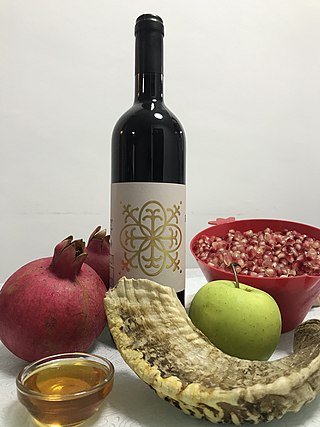
Rosh Hashanah is the New Year in Judaism. The biblical name for this holiday is Yom Teruah. It is the first of the High Holy Days, as specified by Leviticus 23:23–25, that occur in the late summer/early autumn of the Northern Hemisphere. Rosh Hashanah begins ten days of penitence culminating in Yom Kippur, as well as beginning the cycle of autumnal religious festivals running through Sukkot which end on Shemini Atzeret in Israel and Simchat Torah everywhere else.
Yom tov sheni shel galuyot, also called in short yom tov sheni, means "the second festival day in the Diaspora". This is a principle in halakha that mandates the observance of an additional day for Jewish holidays outside the Land of Israel.

The Avodah is a poetic description of the Yom Kippur Temple service. It is recited as part of the Mussaf service of Yom Kippur, and is often considered one of the most solemn and impressive portions of the Yom Kippur prayer service. Different poems are recited in different communities, for example Amitz Koach among most Ashkenazi Jews and Atah Konanta among most Sephardic Jews.
References
- ↑ Journey Through the Machzor - Yom Kippur Seder Ha'Avodah
- ↑ Talmud Bavli, Ta'anit 2a
- ↑ בני עקיבא – תנועה של עם ?